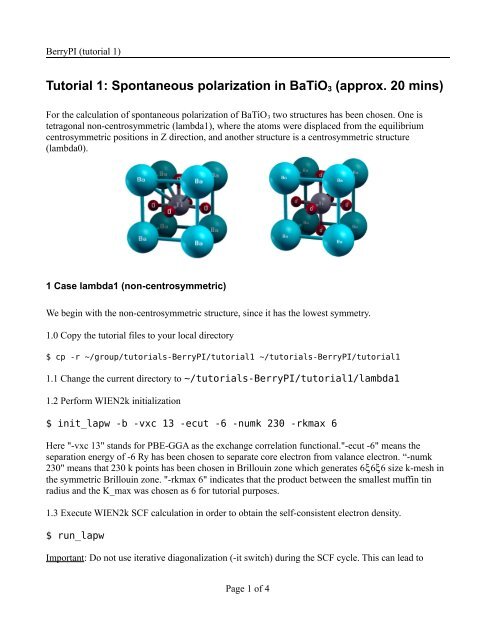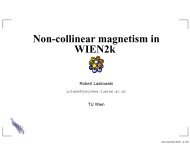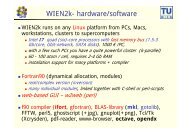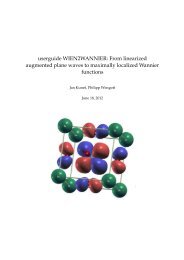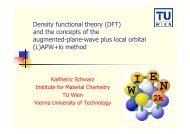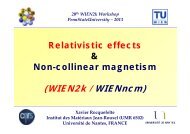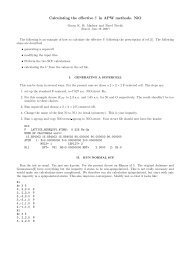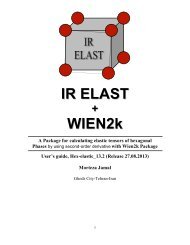Tutorial 1: Spontaneous polarization in BaTiO3 (approx ... - WIEN 2k
Tutorial 1: Spontaneous polarization in BaTiO3 (approx ... - WIEN 2k
Tutorial 1: Spontaneous polarization in BaTiO3 (approx ... - WIEN 2k
You also want an ePaper? Increase the reach of your titles
YUMPU automatically turns print PDFs into web optimized ePapers that Google loves.
BerryPI (tutorial 1)<strong>Tutorial</strong> 1: <strong>Spontaneous</strong> <strong>polarization</strong> <strong>in</strong> BaTiO 3 (<strong>approx</strong>. 20 m<strong>in</strong>s)For the calculation of spontaneous <strong>polarization</strong> of BaTiO 3 two structures has been chosen. One istetragonal non-centrosymmetric (lambda1), where the atoms were displaced from the equilibriumcentrosymmetric positions <strong>in</strong> Z direction, and another structure is a centrosymmetric structure(lambda0).1 Case lambda1 (non-centrosymmetric)We beg<strong>in</strong> with the non-centrosymmetric structure, s<strong>in</strong>ce it has the lowest symmetry.1.0 Copy the tutorial files to your local directory$ cp -r ~/group/tutorials-BerryPI/tutorial1 ~/tutorials-BerryPI/tutorial11.1 Change the current directory to ~/tutorials-BerryPI/tutorial1/lambda11.2 Perform <strong>WIEN</strong><strong>2k</strong> <strong>in</strong>itialization$ <strong>in</strong>it_lapw -b -vxc 13 -ecut -6 -numk 230 -rkmax 6Here "-vxc 13" stands for PBE-GGA as the exchange correlation functional."-ecut -6" means theseparation energy of -6 Ry has been chosen to separate core electron from valance electron. “-numk230" means that 230 k po<strong>in</strong>ts has been chosen <strong>in</strong> Brillou<strong>in</strong> zone which generates 6ξ6ξ6 size k-mesh <strong>in</strong>the symmetric Brillou<strong>in</strong> zone. "-rkmax 6" <strong>in</strong>dicates that the product between the smallest muff<strong>in</strong> t<strong>in</strong>radius and the K_max was chosen as 6 for tutorial purposes.1.3 Execute <strong>WIEN</strong><strong>2k</strong> SCF calculation <strong>in</strong> order to obta<strong>in</strong> the self-consistent electron density.$ run_lapwImportant: Do not use iterative diagonalization (-it switch) dur<strong>in</strong>g the SCF cycle. This can lead toPage 1 of 4
BerryPI (tutorial 1)2.4 Rename all lambda1.* files to lambda0.* files with$ rename_files lambda1 lambda02.5 Restore orig<strong>in</strong>al k-mesh tak<strong>in</strong>g <strong>in</strong>to account the symmetry$ x kgenwith 230 k-po<strong>in</strong>ts (shifted)2.6 Initialize the electron density accord<strong>in</strong>g to the new structure$ x dstart2.7 Run standard SCF cycle.$ run_lapw2.8 Run BerryPI$ berrypi -p$(pwd) -k6:6:62.9 Once the calculation is completed the results will be pr<strong>in</strong>ted like this---POLARIZATION IN C/m^2 FOR [0 to 2] PHASE/2PI RANGE---TOTAL POLARIZATION: [ _____________ , _____________ , ______________]---POLARIZATION IN C/m^2 FOR [-1 to +1] PHASE/2PI RANGE---TOTAL POLARIZATION: [ _____________ , _____________ , ______________]3 <strong>Spontaneous</strong> <strong>polarization</strong>Calculation of <strong>Spontaneous</strong> Polarization us<strong>in</strong>g the Z components of <strong>polarization</strong>s obta<strong>in</strong>ed <strong>in</strong> lambda1and lambda0.The spontaneous <strong>polarization</strong> is def<strong>in</strong>ed as the difference <strong>in</strong> the <strong>polarization</strong> between thecentrosymmetric (lambda1) and non-centrosymmetric (lambda0) structures.P_s= P_z(lambda1)- P_z(lambda0)=____________ - ___________ = ____________ C/m^2Page 3 of 4
BerryPI (tutorial 1)Check whether the different π -wrapp<strong>in</strong>gs affect the result? Here only Z components of <strong>polarization</strong>is considered because the atoms <strong>in</strong> non-centrosymmetric structure are displaced only <strong>in</strong> Z directionrelative to the centrosymmetric structureThe obta<strong>in</strong>ed spontaneous <strong>polarization</strong> value can be compared to the experimental spontaneous<strong>polarization</strong> of 0.26 C/m^2 [1] and other DFT values of 0.22- 0.29 C/m^2 [2-3].[1] H.H. Wieder Phys. Rev., 99 (1955), p. 1161[2] M. Fechner, S. Ostan<strong>in</strong>, I. Mertig Phys. Rev. B, 77 (2008), p. 094112[3] J.J. Wang, F.Y. Meng, X.Q. Ma, M.X. Xu, L.Q. Chen J. Appl. Phys., 108 (2010), p. 034107Page 4 of 4


